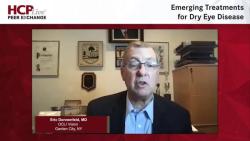Advances in the Management and Treatment of Dry Eye Disease - Episode 3
Pathophysiology of Dry Eye Disease
Brandon Ayres, MD, discusses the pathophysiology of dry eye disease related to obstruction and inflammation.
Kendall Donaldson, MD, MS: Brandon, I was wondering if you could comment about the inflammatory cascade, the inflammation that leads to problems with dry eye? Maybe even [discuss] some of the impact of systemic disease and various autoimmune conditions that can worsen that process.
Brandon Ayres, MD: We could write, and there have been entire books written, on this topic. And I think the more we learn, the more we understand that we don’t understand. But especially in talks like this, we all have to agree that ocular surface disease has an inflammatory basis. There are all [kinds of] different components that go into that. I’ll try to deal with this on a low level, and then maybe Laura, you can come back and fill in the blanks, because Laura’s an expert in ocular immunology.
I’m going to put this into 4 buckets. We have our lacrimal functional unit, and it has a healthy tear film that’s running on these homeostatic mechanisms. Every organ, everybody, every eye has this innate immune system, which means there are resident inflammatory cells sitting on the ocular surface, duking it out with the environment and chemicals and trauma. These are things like macrophages, natural killer cells, dendritic cells, Langerhans cells, you name it. Now, they see some kind of an inflammatory event, whether it’s a trauma, a chemical, a noxious gas, or maybe a medication that was taken by the patient, and this innate system is going to signal an adaptive system. This is through a system of interleukins and chemokines and all kinds of fancy words, IL-1 [interleukin-1], IL-2, tumor necrosis factor. It’s going to talk to these cells in resident lymph nodes to make a specific or adaptive immunity. So now these other cells are being called to the ocular surface with specific antigens that were initially seen on the surface.
This all goes through cell rolling, it’s all through the whole ICAM-1 [intracellular adhesion molecule-1]/LFA-1 [leukocyte function-associated antigen-1] interaction pulling these specific inflammatory cells to the ocular surface so they can combat whatever they need to combat. That’s the inflammation that can lead to ocular surface disease. This is supposed to be self-regulated. So once that inflammation gets upregulated, other cells on the ocular surface—and I think the goblet cells play a big role here—[tell] the adaptive inflammatory cells, you have done your job, it’s time to quiet down and get the ocular surface quiet again. With chronic inflammation, sometimes it gets a little dysregulated, and we end up with auto self-antibodies, or with destruction of goblet cells and other regulatory cells, where it can’t quiet the ocular surface inflammatory response. That is the circle of inflammation that we’ve all seen and talked about.
Now, you take that, and you add other autoimmune diseases, say Sjogren syndrome or secondary Sjogren syndrome with somebody who has rheumatoid arthritis. Or systemic diseases like smoking, peripheral artery disease, more severe diabetes, and some of these other conditions. You further dysregulate the ocular surface, and it just can’t get quieted down, and you have to then intervene with some kind of medication or treatment to restore that ocular surface to its normal homeostasis and a happy tear film. That’s my version of inflammation on the ocular surface. Laura, how did I do, and what did I miss?
I. Paul Singh, MD: You’re showing off right now, Brandon. It was great.
Kendall Donaldson, MD, MS: That was something. You did pretty well. What do you think, Laura?
Laura Periman, MD: Bravo, that was great.I love your hat tip to the goblet cells, those are so important from an immunoregulatory perspective. That’s why we care about goblet cell density, you can only get there through inflammation control. I think of all those inflammatory mediators you talked about as being goblet cell kryptonite, and goblet cells are the superhero of the ocular surface. They have this amazing immunoregulatory function, but their kryptonite is that chronic inflammation. You’ve got to get it under control so the goblet cells can come back out, the population can recover, and you can get immunoregulation, which helps lead back to homeostasis.
TRANSCRIPT EDITED FOR CLARITY



